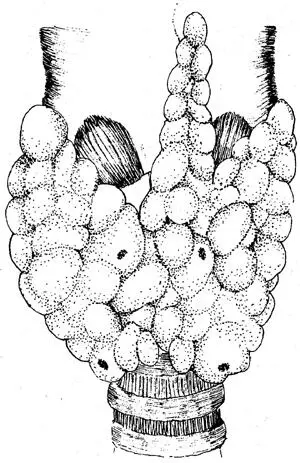The thyroid is a small, soft, butterfly-shaped gland that weighs just 15–20 g ( 1/ 2– 3/ 4oz) and is about the size of a plum, yet it is also the largest pure endocrine gland in the body. It lies across the front of the windpipe (trachea) just below the larynx, or voice box ( see Figure 2.3 ). Its two lobes, or sections, lie on either side of the Adam’s apple and are joined together by a narrow bridge of tissue called the isthmus.
You may just be able to detect its outline if you look in the mirror and stretch your neck. If you take a sip of water and swallow, you may be able to see it moving up and down. If you can’t see it, you may be able to feel it with your fingers. (But don’t worry if you can’t see or feel it – not everyone can.)
The thyroid develops in the womb during the first weeks of life from a small piece of tissue at the root of the tongue. As the fetus grows, the tissue moves down the neck to rest at its adult position. By the time the fetus is just 12 weeks old, the thyroid has already started to work.
The thyroid is made up of two types of hormone-secreting tissue: follicular cells and parafollicular cells. The follicular cells, which make up the greater part of the thyroid, are hollow spheres surrounded by tiny capillary blood vessels, lymphatic vessels and soft connective tissue. Each follicle is filled with a yellow, semifluid, protein-containing material called thyroglobulin (TG) which, when broken down, interacts with

Figure 2.3 The thyroid gland lies across the windpipe in the throat.
iodine stored in the thyroid to produce thyroid hormone (TH). The parafollicular cells lie on their own or in small clusters in the spaces between the follicles and secrete another hormone – calcitonin.
The thyroid’s main purpose is the production, storage and release of thyroid hormone. Although referred as a single entity, there are, in fact, two thyroid hormones: thyroxine (T 4) and triiodothyronine (T 3), which carry four and three atoms of iodine, respectively.
T 3is four times more potent than T 4and works eight times more quickly. Yet, T 4is about 50 times more abundant in the bloodstream than T 3. This is because, although small amounts of T 4are converted to T 3within the thyroid gland itself, most T 3is produced outside of the thyroid by a process called monodeiodination, which strips away one of the iodine atoms from T 4. This allows the body to produce T 3as needed – like changing your five-pound notes into one-pound coins for the parking meter.
Like all of the glands in the body, the thyroid is regulated and controlled by the pituitary gland, the small, pea-sized gland attached to the brain often referred to as the ‘master gland’. The pituitary gland orchestrates the entire hormonal symphony but is, in turn, driven by the hypothalamus, to which it is joined by a short stalk of nerve fibres. This hypothalamic – pituitary – thyroid gland connection is a key junction through which chemical messages are carried to and from the brain and the body.
Levels of thyroid hormone are regulated by a feedback loop that operates between the hypothalamus, pituitary and thyroid glands. Anything that increases the body’s need for energy – such as a fall in temperature or a bout of exercise – will provoke the hypothalamus to secrete a chemical messenger called thyrotropin-releasing hormone (TRH) to trigger the pituitary to secrete a messenger chemical called thyrotropin or thyroid-stimulating hormone (TSH), which stimulates the thyroid to secrete thyroid hormone. As the thyroid releases increasing amounts of TH, chemical messages are eventually passed on to the hypothalamus to inhibit production of TRH and, in turn, TSH.
This chemical round-robin means that TSH levels are a highly sensitive indicator of thyroid activity and can provide an early clue that the thyroid is not working as it should. This is why the TSH test is a key investigation in checking the health of your thyroid ( see Chapter 4 ).
The thyroid is crucial in maintaining the strength and density of our bones. The parafollicular cells of the thyroid produce the hormone calcitonin, which is involved in regulating calcium levels in the body. As well as being the main mineral used for making bone, calcium is needed to trigger impulses in nerve and muscle cells.
Calcitonin acts with another hormone – parathyroid hormone (PTH) – produced by the parathyroid glands, four tiny glands that lie behind the thyroid. Whenever calcium is needed, PTH raises the levels of calcium in the blood by stimulating the release of calcium from bone, increasing the reabsorption of calcium from the kidneys and converting vitamin D into a hormone that increases gut absorption of calcium. Once calcium levels have been increased, the thyroid releases calcitonin to suppress the release of calcium from bone.
Although the thyroid is only a small gland, the hormone it produces is responsible for an incredible number of biological processes. In fact, it would be fair to say that TH is essential for the health of virtually every cell in your body. Cell growth, muscle strength, body temperature, appetite, cholesterol levels, mood and memory all depend on thyroid hormone. Likewise, your heart, liver, kidneys, reproductive organs, hair and skin all require TH to function properly.
So widespread is the activity of TH that, indeed, in Victorian times, doctors believed the thyroid was vital to life. Although it is possible to live without a thyroid, provided you receive thyroid-hormone replacement therapy, they were not that far from the truth. Thyroid hormone is unique in that, throughout the whole of our lives, it acts within almost every tissue in the body and is vital for general health and wellbeing.
The main job of thyroid hormone is to regulate your metabolism – the rate of your body’s cell activity. It does this by activating mitochondria, the tiny cellular ‘powerhouses’ that produce energy. The process of metabolism – the word literally means ‘change’ – among other things, controls your appetite and maintains your body temperature, whatever the external environment.
Your metabolism determines the rate at which your cells burn oxygen, a process involved in every activity of life – from breathing and sleeping to eating, talking and moving around – as well as all the activities of your internal organs, such as the beating of your heart, the digesting of your food, the functioning of your reproductive organs and, most important of all, the working of your brain.
Thyroid hormone is active when the embryo is still in the womb, where it plays a crucial part in helping each of the millions of cells in our bodies to become more specialized. It is this process, known as differentiation, that turns tadpoles into frogs and a human embryo to develop from a tiny cluster of cells into a fully grown baby.
At the other end of life, the thyroid is thought to play an equally important role in the control of ageing.
In the womb and after birth, thyroid hormone is vital for both mental and physical growth. With somatotrophin (STH) from the pituitary, it determines the length and strength of your bones. During childhood, lack of TH stunts growth by preventing the bones from growing and maturing. TH is also crucial for the normal development of the brain and nervous system in both the unborn and newly born infant. During pregnancy, low levels of T 4can affect brain development, resulting in mild-to-severe mental deficiencies. In the past, the term used to describe these defects was ‘mental cretinism’.
Читать дальше













